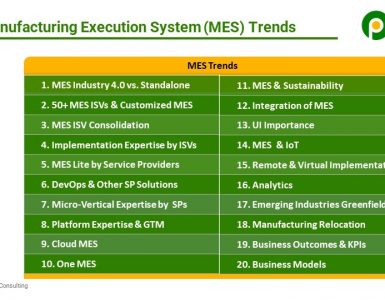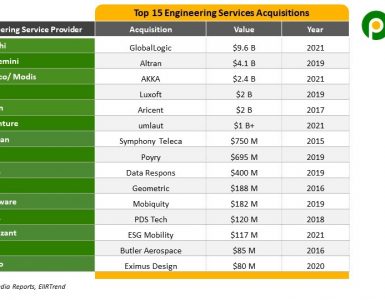Large Deal Imperative in Engineering Services
Engineering service providers face mounting pressure to scale and secure large, multi-year contracts. Large deals are critical for revenue visibility, investor confidence, and long-term growth.
However, these deals demand more than delivery depth, they require domain breadth, transformation capabilities, and customer trust. Winning such contracts is a true litmus test of a provider’s strategic relevance.
- They drive sustained growth in a fragmented, competitive industry.
- They validate capabilities, as clients won’t award transformation-scale contracts without trust.
- They signal credibility both internally and to the market.
So, how can engineering service providers win large deals? One way is through capability-driven acquisitions.

Capability Acquisition Advantage
Organic capability development in engineering is slow, talent-intensive, and geographically constrained. Acquisition is a key strategy for building capabilities in engineering services. Developing these capabilities organically is challenging, particularly in the highly specialized field.
Take the case of automotive engineering. Many IT service providers have automotive clients but lack the engineering expertise and credentials needed to secure engineering work. These credentials include specialized engineering talent and strong customer references. Often, the only way to gain access to customers is by acquiring an existing engineering service provider. Even for established players in automotive engineering, expanding into new areas is difficult, and acquisitions offer a fast-track solution to build the necessary capabilities and credentials.
So, strategic acquisitions are emerging as a credible pathway to add critical capabilities, enter new domains, and build the credibility needed to compete for marquee contracts. Acquisitions can fill capability gaps, bring anchor clients, boost credibility, and help firms qualify for mega RFPs. They allow engineering services firms to leapfrog multi-year capability development cycles.
In short, acquisitions in engineering services are not just about revenue; they are about capability enablement.
But how do we judge the success of these acquisitions? The answer lies in large deals.
Large Deals Driven by Capability Acquisitions
The real test of acquisition success lies not in integration speed or headcount gains, but in deal flow. Did the acquired capability result in winning new large contracts? If yes, that’s success. Key signals of success:
- Acquired teams are embedded into pursuits within 3–12 months
- The firm qualifies for larger or more complex bids
- New wins emerge in the acquired domain or geography
Several engineering service providers have successfully used acquisitions to unlock large, strategic deals:
- LTTS acquired SWC, a cybersecurity-focused firm, which enabled it to secure a $100 million cybersecurity project with the Government of Maharashtra—one of the largest public-sector engineering-led digital security deals in India.
- Infosys’ acquisition of German automotive engineering specialist in-tech helped it strengthen its footprint in the software-defined vehicle (SDV) domain, resulting in a significant win with Polaris, a leading automotive OEM.
- HCLTech, after acquiring ASAP Group—a German automotive engineering firm—won new engineering mandates from Volvo, accelerating its entry into the SDV and electrification space.
- KPIT Technologies’ acquisition of Technica Engineering positioned it as a credible partner for Renault, helping it win a $100 million SDV engineering deal with the French OEM.
These examples highlight how capability-led acquisitions can translate into tangible deal wins, validating the strategic value of M&A beyond financial consolidation.
Playbook for Acquisition Driven Large Deals
Capability
- Build capabilities through targeted acquisitions
- Select acquisition targets aligned with capability gaps and future market demand
- Integrate acquired capabilities into the existing organizational structure
- Retain domain experts and align delivery systems for consistency and scale
Opportunity
- Identify large deal opportunities with existing clients and prospects
- Rapidly embed new capabilities into sales playbooks
- Rebrand offerings to signal transformation readiness
- Leverage acquired credibility to qualify for mega RFPs or proactively pursue sole-sourced deals
Execution
- Craft a winning value proposition
- Develop a robust technical solution
- Optimize financial structuring and deal economics
Sweet Spot = Capability × Opportunity × Execution
Without all three, acquisitions risk becoming stranded assets.
Bottomline:
Engineering service providers that treat M&A as a core growth strategy, not a financial tactic, will be best positioned to lead. With the right approach, acquisitions can become a catalyst for landing the large deals that define industry leadership.
M&A is not just about revenue addition—it’s about capability-led growth. Service providers should ask: Can we bring large deals with this acquisition?
If yes, that’s the real metric of M&A success.
Treat acquisitions not as financial maneuvers but as growth catalysts, and they’ll help you scale smart.






 Pareekh Jain
Founder of Pareekh Consulting & EIIRTrends
Pareekh Jain
Founder of Pareekh Consulting & EIIRTrends
Add comment